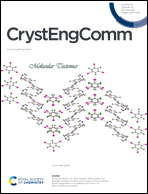A newly-constructed hydrolytically stable Co(ii) coordination polymer showing dual responsive fluorescence sensing of pH and Cu2+†
Abstract
Fluorescent chemosensors based on coordination polymers (CPs) have received particular attention in monitoring the pH values and appropriate analytes in environmental and biological systems owing to their extreme superiorities. Herein, a novel solvent-dependent fluorescent Co(II)-CP, [Co(asba)(2-mmzm)(H2O)2]·3H2O (1), was obtained through the assembly between Co2+ and 2-amino-4-sulfobenzoic acid (H2asba) in the presence of the flexible hydrophobic ligand 1,4-bis[(2-methyl-1H-imidazol-1-yl)methyl]benzene (2-mmzm). 1 is a 1D coordination polymer, which is further linked by a 1D hydrogen-bonded tape into a 3D supramolecular network. 1 shows high hydrolytic stability as well as strong acidic and basic resistance. Remarkably, 1 is a quite rare example that shows dual responsive fluorescence sensing of pH and Cu2+. 1 shows distinct sensing behavior toward pH with interesting different sensing mechanisms in three continuous pH ranges. Moreover, 1 demonstrates high accuracy in determining the pH of artificial gastric juices. 1 could also sensitively and selectively sense Cu2+ ions over a number of interfering metal ions. The limit of detection (LOD) for Cu2+ reaches the 2.4 μM level.

- This article is part of the themed collection: Coordination Networks


 Please wait while we load your content...
Please wait while we load your content...